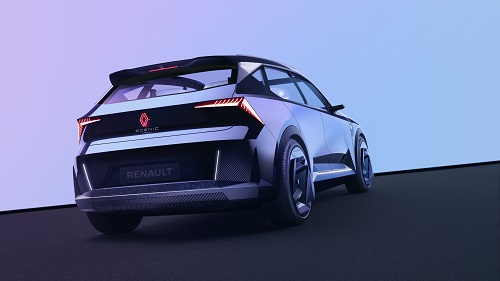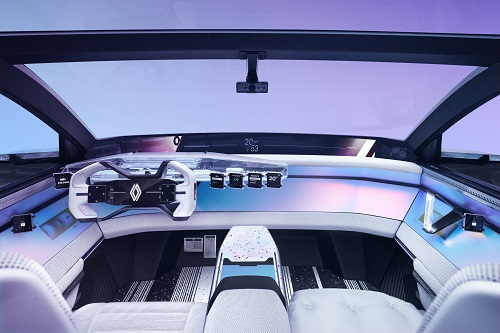Renault is writing a new chapter in its history with the Scenic Vision, an innovative concept car that brings the brand’s vision for a greener, safer and more inclusive future to life.
The Scenic Vision embodies the brand’s sustainable development commitments and encapsulates them in a single vehicle. Its intelligent design and manufacture incorporate methods that the Renault Group and its brands will use to achieve carbon neutrality in Europe by 2040 and worldwide by 2050. Notably, this includes Renault aiming for an entirely electric range by 2030.
Outside, the Scenic Vision showcases Renault’s future all-electric family cars. Inside, it invites travellers into a new time, a future where technology and innovation will make the world more sustainable and more environmentally-friendly.
The Scenic Vision concept car brings the most futuristic decarbonisation technologies to life today, and it embodies the three pillars of Renault Group’s sustainable development strategy: carbon neutrality, safety and inclusion.
For example, 70 per cent of its materials are recycled and 95 per cent are recyclable – contributing directly to resource preservation. As a hybrid, utilising both electric and hydrogen power, it requires fewer and shorter stops. Its carbon footprint, including the battery, is much smaller, being 75 per cent lower than that of a conventional electric car and being a zero-emission car (in production and in use).
The technology in the car enhances driver and passenger safety by reducing the number of accidents by up to 70 per cent. The design of the Renault Scenic Vision also mirrors the development teams’ intention to create a car that is unique, accessible to all and right for everyone.
Measuring 4.49 meters in length (1.9 m wide and 1.59 m high), the Renault Scenic Vision is a family car whose dimensions are that of a C-segment vehicle. Its features contribute to an overall futuristic design with plenty of character and a sustainable underbelly.
The vehicle boasts all the advantages of a family car: extended wheelbase, low belt line, large wheels, side and wheel-arch protective strips, and a horizontally aligned bonnet. Its proportions are ideal for optimised interior space.
The highly detailed front end of the Scenic Vision concept car features sculpted surfaces that converge in a dynamic flow of clearly visible lines; it is enhanced by a spectacular welcome sequence during which the front bonnet gives way to a flash diamond-shape animation that comes alive on the grille before rising up around Renault’s new ‘Nouvel’R’ logo.
Close attention to detail can be seen in the rims, bumper air intakes, front grille components, and more; everything has been done to showcase the car’s HD design. The logo is also part of the highly graphic style: each of its lines can be broken into fifths.
The headlights and day lamps feature the same stylistic lines as the logo, thereby further underpinning the feeling of unity with the front end’s design.
All it takes to open the doors is a simple touch of the tactile Renault logo located on the replacement B-Pillar, with the suicide doors and non-existent B-Pillar allowing easy access.
Fitted with large 21-inch wheels, the rims on the Renault Scenic Vision are equipped with flaps for enhanced aerodynamic performance, and therefore greater efficiency. When the car is in motion (≥ 10km/h), the flaps close to improve their aerodynamics; as soon as the car slows down and its speed drops below 10km/h, the flaps open for better cooling as the heat generated by the brakes can escape more readily. A specific mechanism keeps the logos positioned on the wheels in an upright position when the Scenic Vision is in motion.
The interior of the Renault Scenic Vision interior adapts to each person on board; a truly visionary philosophy.
As such, when climbing aboard, the cockpit and seats move back, so as to give passengers and the driver maximum room to move around in. They then move back to a more suitable position by adapting to the morphology of each user. The seats have been designed to suit their primary function. The wrap-around driver’s seat is sportier than the others, making it easier to stay focused on the road when driving; whereas passengers benefit from seats designed to be more comfortable.
The steering wheel is in the shape of a game controller, underscoring the interior’s modern ‘tech’ feel. The vehicle’s large glass roof lets in light, inviting passengers to let their minds wander, and merging with the other glass panels to give a heightened sense of space and luminosity. This is enhanced by the choice of light-coloured, reflective materials.
With the ‘Cocoon’ airbags now located in the seats, the dashboard is thinner and sleeker. The Renault Scenic Vision comes equipped with a very large screen located where the windshield meets the dashboard, as close as to the horizon line as possible. The goal is to give the driver the best possible view. Its position maximizes ergonomics and safety by preventing the driver from taking their eyes off the road as they look for information which is displayed in two distinct areas: one for the driver, one for the passenger.
In addition to the main screen, the interior also features 10 small widget screens, that are readily adaptable, intuitive and configurable, and which control functions spanning everything from music to temperature settings and settings for the automatic gearbox to interior lighting. Content from the widgets can be transferred to the large screen on the dashboard.
A final addition to the Renault Scenic Vision’s on-board equipment is the HEPA filter which helps purify the air inside the car, thus enhancing the well-being and health of passengers.



